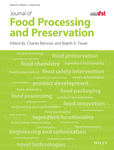Analysis of the effects of thermal protein denaturation on the quality attributes of sous-vide cooked tuna
Funding information: Japan Society for the Promotion of Science, Grant/Award Number: P16102
Abstract
Traditional (low temperature, long time) and novel (low temperature, short time) sous-vide cooking of lean tuna were characterized by analyzing the effects of thermal protein denaturation (TPD) on quality attributes, such as color, appearance, shrinkage, drip loss, and texture. TPD was analyzed by differential scanning calorimetry and estimated for several thermal schedules by kinetic analysis, following the dynamic method. When heated at a rate of 10 °C/min, myosin began to denature at around 35 °C. Actin did not denature, even when the temperature rose to approximately 51 °C, until the denaturation of myosin was complete. However, actin began to denature at approximately 58 °C and was completely denatured at 76 °C. Actin denaturation had a stronger effect than myosin denaturation on texture changes, whereas myosin denaturation was responsible for changes in color and appearance. A better preservation of tuna quality was obtained by novel sous-vide cooking over the traditional sous-vide method.
Practical applications
The results of this study are useful to both the research community and industry because they provide quantitative characterization of the consequences of sous-vide cooking method on food quality explained by estimating TPD. Moreover, the kinetic parameters of the denaturation rate collected for kinetic modeling of the TPD of tuna, not only have application to simulate denaturation of actin and myosin under different thermal schedules of sous-vide cooking, but also they can be used for the analysis of additional thermal treatments.




